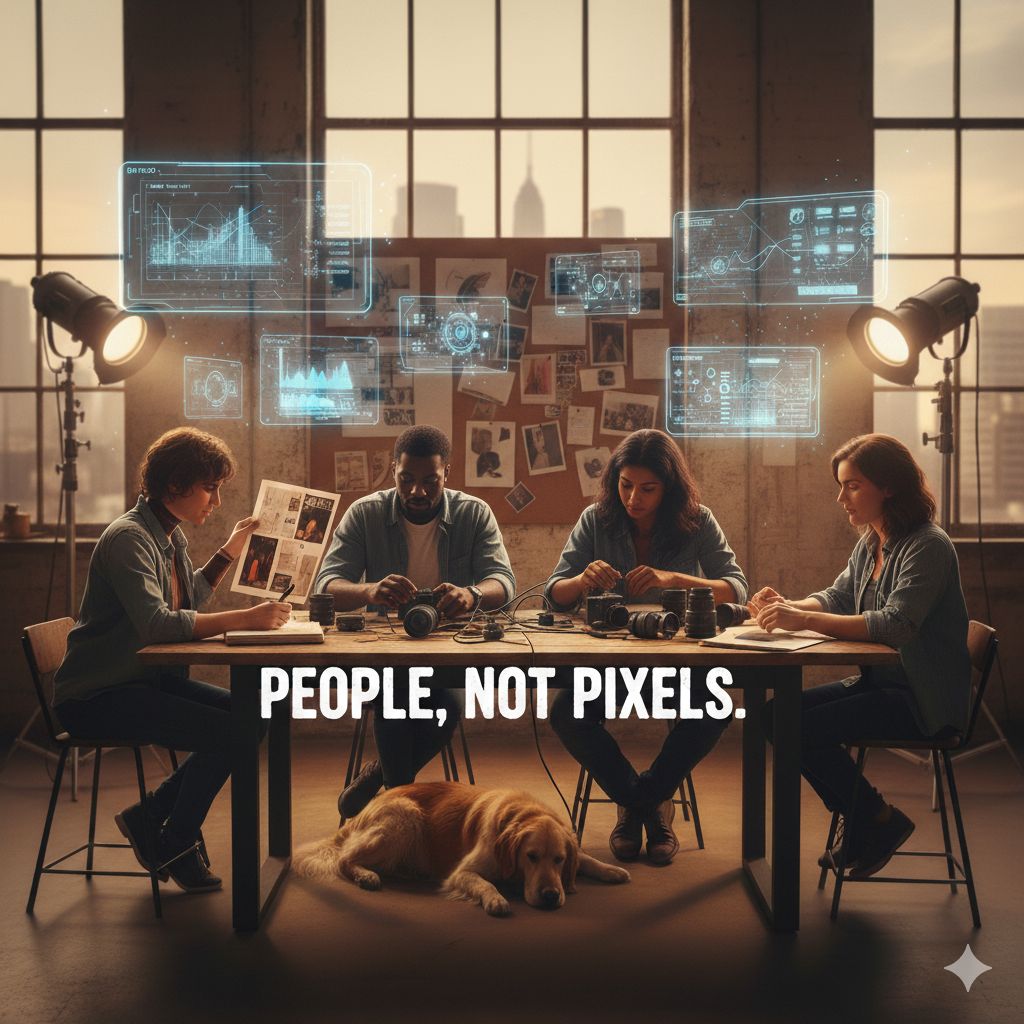- Pathways by Enterprising Minds
- Posts
- Sometimes the Old Ways Are Better
Sometimes the Old Ways Are Better
What a work trip reminded me about creativity, collaboration, and human context

I recently flew to Atlanta for a video and photo shoot. The team was a group I’ve worked with before but mostly from a distance. This time, we were all in the same room. We had gear to set up, people to direct, real-time decisions to make, legal and safety things to remember, and a schedule to stay on top of.
After months of screen-based work, it felt good to do something physical. Not just checking off digital to-dos but making something real. We wrapped the shoot, packed up the lights, and went out for a drink. That simple rhythm of working, finishing, then celebrating, felt grounded in a way digital work often doesn’t.
In a productivity-obsessed, automation-heavy, performance-driven industry like marketing, there’s still something uniquely valuable about making things the messy, inefficient way. With people, not pixels.
Especially now, when the pace of synthetic content is only accelerating.
Sora 2 and the Future of Trust
The shoot happened days after OpenAI announced Sora 2. If you haven’t seen it yet, it’s a big leap in AI-generated video. The results are smoother, longer, and more controlled than anything we've seen before. And as you'd expect, it sparked plenty of conversation around the happy hour table about what’s real, what’s not, and how any of us can tell the difference.
For me, there are some clear use cases that unlock some opportunities for groups that wouldn’t have had access previously. For example, independent musical artists with no budget can get visuals that look professionally made for a music video. Agencies, or brands, can conceive a campaign without a crew.
But there are still categories where real people matter more than perfect visuals. Ads for medicines are a clear example. Those TV spots showing people walking dogs through parks aren’t just a creative choice; they’re designed to feel authentic. Viewers need to believe the people on screen are real and relatable. Even when you know they’re actors, you still respond to human expressions, natural timing, and the subtle imperfections that AI hasn’t yet mastered.
B2B industrial marketing is another safe zone, at least for now. If your product is niche, complex, or physical, your buyers are looking for technical credibility. If you’re speaking to experts who deal in physical systems, real environments, and regulated products, fabricated visuals won’t cut it. Those buyers know what authentic looks like.
The line between believable and performative is becoming more important. It’s not about rejecting AI; it’s about knowing where it fits.
People, Not Pixels
What stood out from the Atlanta trip wasn’t just what we made, it was how we made it. The casual problem-solving, the quick adjustments, the feedback that didn’t need to be typed or scheduled, the office dog, etc. There’s something about being in the same space that accelerates collaboration in a way software can’t.
We’ve become so optimized for performance metrics, dashboards, and asynchronous workflows that we forget what a real team dynamic feels like. Not the Zoom version; the one where you solve problems by reading the room or share a joke that doesn’t require a meme. The version where trust builds without a single status update.
Most times, it’s the hangout after the deadline that builds trust. Sometimes it’s the tension before the shoot that sharpens focus. Sometimes, just being in a new place with smart people changes the way you think.
In an industry that moves fast and rewards scale, these moments matter more than we realize. Because they can’t be templatized, scheduled, or prompted. They only show up when you do.
Why It Matters
As AI continues to change how we produce, market, and scale creative work, the value of in-person collaboration—of shared space and shared context—isn’t going away. It’s increasing. Not everything needs to be generated, optimized, or sped up. There are parts of our work—especially those involving trust, nuance, and emotion—that benefit from being done the slower, more traditional way.
The gap between synthetic and human is narrowing, but the trust difference isn’t. People still recognize people. We still trust what we can feel, not just what we can see.
Knowing where to draw that line, taste, is going to be a competitive advantage.
The marketers who win won’t be the ones with the most automation; they’ll be the ones with the best judgment. They’ll know when to lean on AI and when to get on a plane.
Final Thought
AI is going to keep getting better. That’s not the question. The real question is what kind of work we still want to do ourselves.
Sometimes, making something real with real people, in a real place, is the best reminder of what we’re actually good at.
The next time you're planning a project, ask yourself: Is this a job for automation or a moment that deserves to be human?
Chances are, it’s both. So, use the tools. Embrace the automation. But make sure you’re still building with people, not just pixels.
Practical Moves for Marketers
Be selective about where AI fits. Match the medium to the message. AI-generated video is great for inspiration or abstract ideas, so use generative video where emotion and realism aren’t dealbreakers.
Highlight authenticity for high-trust content. In categories where believability drives conversion, like healthcare, finance, or enterprise tech, prioritize real humans.
Don’t outsource human moments. The small stuff you pick up on set or in a strategy room often makes the work and teams better. Create space for that.
Reframe your metrics. Not everything valuable is measurable. Team cohesion, creative flow, contextual insight, and spontaneous ideas matter too and won’t show up in a dashboard.
Find more insights like this on the podcast and Enterprising Minds blog!
Share the Love!
If you know anyone who could benefit from this content, please share it!